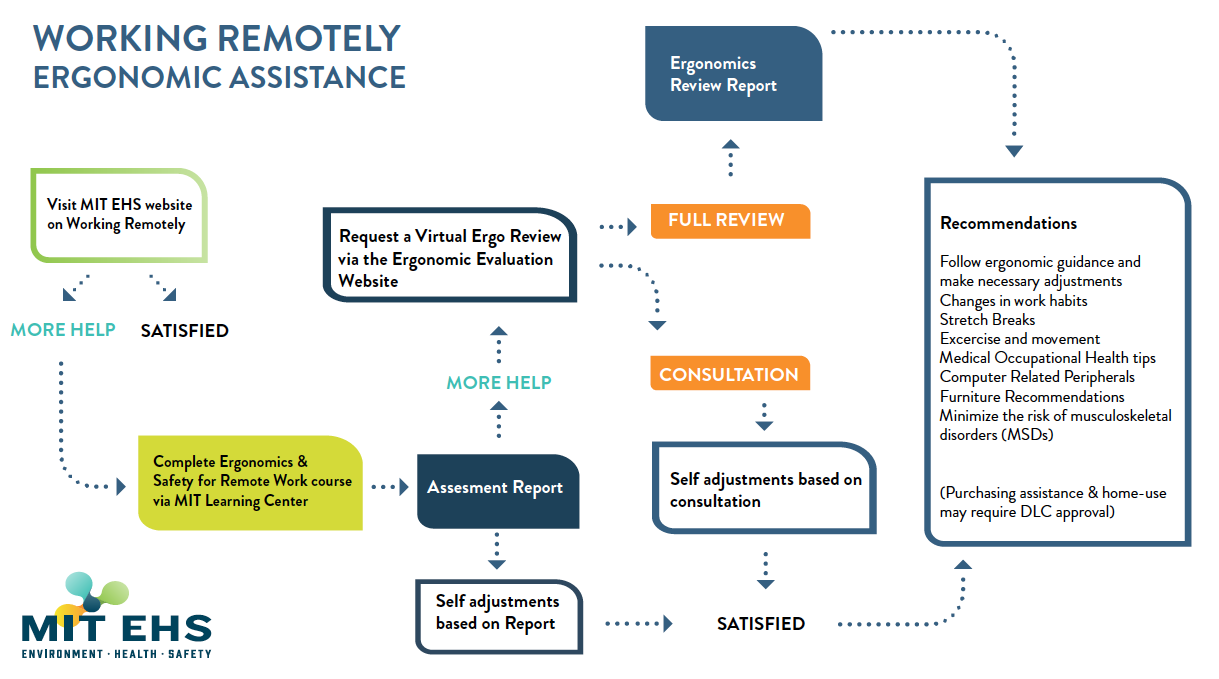MIT’s Environment, Health & Safety Office is offering resources, training, and support for Remote Work during the COVID-19 Pandemic.
From training modules to interactive zoom sessions and one-on-one consultations, MIT EHS is offering the MIT community workplace ergonomics resources, assessment tools, and safety guidance for remote work.
Under normal circumstances, MIT EHS’s Industrial Hygiene Program provides ergonomics support for students, staff, and faculty to help provide a workspace that is comfortable and productive with an underlying goal of preventing injuries and musculoskeletal disorders (MSDs).
When the COVID-19 pandemic hit, suddenly members of the MIT community were working from their homes or other locations, in many cases under challenging ergonomic conditions. Under the leadership of Iraj Aalaei, Bob Edwards and other EHS subject matter experts working closely with campus stakeholders, the EHS Office has created a robust framework with set of customizable resources to support MIT employees working remotely.
“Remote work poses a whole host of safety and ergonomic challenges,” says Tolga Durak, Managing Director of EHS Programs.“By offering resources, training, and individual guidance, we hope to minimize injuries, illness, and accidents. Our focus has never shifted from helping members of our community in pursuit of a working environment free from recognized hazards.”

EHS’ Offerings: From Best Practices for Working Remotely to One-on-One Consultations with Ergonomics Experts
EHS’s slate of resources begins with a website hub of information, guidelines, and best practices for working remotely. From tips on how to position laptops and desks to resources on managing working hours, reducing fire hazards, and wellness, the website has a wealth of guidance for creating safe remote working conditions.
From the Working Remotely website, community members are encouraged to complete an online Ergonomics & Safety for Remote Work course and self-assessment. Users receive an assessment report based on their answers, along with tailored recommendations for ergonomics improvements to their working conditions.
Because the ergonomic challenges faced by remote workers are so diverse and extensive, MIT EHS is going beyond offering a self-assessment and guidelines: members of the MIT community may request a one-on-one virtual ergonomic evaluation via Zoom with an ergonomic expert. Additionally, EHS is offering expert consultations via phone (campus: 617-452-3477 / LL: 781-981-0963 ) or email (ehs-ergo@mit.edu), as well as webinars for DLCs.

Recommendations from EHS’ ergonomics experts vary widely depending on the differing working conditions faced by community members. Many of the most common recommendations involve changes in work habits, stretch breaks, exercise and movement, medical occupational health tips, computer related peripherals, and furniture recommendations.
“We have had conversations with members of the MIT community working in all kinds of remote environments, all over the world,” says Aalaei, Senior EHS Officer for Industrial Hygiene. “Our office is ready to answer questions and provide guidance and resources to support safe work in most environments.”
Aalaei and the Industrial Hygiene Program have presented webinars to several MIT departments.
“[The webinar] was a great opportunity to learn best practices/postures for working in a remote home office.”Mary Markel Murphy, Senior Associate Dean for the Office of Vice Chancellor
Edwards is encouraging members of the MIT community to take advantage of EHS’ resources as soon as possible. “Poor ergonomics can lead to all kinds of injuries, including carpal tunnel, cumulative trauma, and musculoskeletal issues,” he points out. “We hope the resources we’re offering can be a ‘preemptive strike’ against these kinds of injuries.”
Durak says he hopes that the MIT community will continue making use of the resources that EHS is offering to minimize and eliminate hazards associated with working from home. “We want to support our community in implementing controls and best practices now, to promote health and wellbeing, and create productive, safe remote work environments,” says Durak.
Published by Environment, Health and Safety Office on August 13, 2020
MIT’s Environment, Health & Safety Office is offering resources, training, and support for Remote Work during the COVID-19 Pandemic.
From training modules to interactive zoom sessions and one-on-one consultations, MIT EHS is offering the MIT community workplace ergonomics resources, assessment tools, and safety guidance for remote work.
Under normal circumstances, MIT EHS’s Industrial Hygiene Program provides ergonomics support for students, staff, and faculty to help provide a workspace that is comfortable and productive with an underlying goal of preventing injuries and musculoskeletal disorders (MSDs).
When the COVID-19 pandemic hit, suddenly members of the MIT community were working from their homes or other locations, in many cases under challenging ergonomic conditions. Under the leadership of Iraj Aalaei, Bob Edwards and other EHS subject matter experts working closely with campus stakeholders, the EHS Office has created a robust framework with set of customizable resources to support MIT employees working remotely.
“Remote work poses a whole host of safety and ergonomic challenges,” says Tolga Durak, Managing Director of EHS Programs.“By offering resources, training, and individual guidance, we hope to minimize injuries, illness, and accidents. Our focus has never shifted from helping members of our community in pursuit of a working environment free from recognized hazards.”

EHS’ Offerings: From Best Practices for Working Remotely to One-on-One Consultations with Ergonomics Experts
EHS’s slate of resources begins with a website hub of information, guidelines, and best practices for working remotely. From tips on how to position laptops and desks to resources on managing working hours, reducing fire hazards, and wellness, the website has a wealth of guidance for creating safe remote working conditions.
From the Working Remotely website, community members are encouraged to complete an online Ergonomics & Safety for Remote Work course and self-assessment. Users receive an assessment report based on their answers, along with tailored recommendations for ergonomics improvements to their working conditions.
Because the ergonomic challenges faced by remote workers are so diverse and extensive, MIT EHS is going beyond offering a self-assessment and guidelines: members of the MIT community may request a one-on-one virtual ergonomic evaluation via Zoom with an ergonomic expert. Additionally, EHS is offering expert consultations via phone (campus: 617-452-3477 / LL: 781-981-0963 ) or email (ehs-ergo@mit.edu), as well as webinars for DLCs.

Recommendations from EHS’ ergonomics experts vary widely depending on the differing working conditions faced by community members. Many of the most common recommendations involve changes in work habits, stretch breaks, exercise and movement, medical occupational health tips, computer related peripherals, and furniture recommendations.
“We have had conversations with members of the MIT community working in all kinds of remote environments, all over the world,” says Aalaei, Senior EHS Officer for Industrial Hygiene. “Our office is ready to answer questions and provide guidance and resources to support safe work in most environments.”
Aalaei and the Industrial Hygiene Program have presented webinars to several MIT departments.
“[The webinar] was a great opportunity to learn best practices/postures for working in a remote home office.”Mary Markel Murphy, Senior Associate Dean for the Office of Vice Chancellor
Edwards is encouraging members of the MIT community to take advantage of EHS’ resources as soon as possible. “Poor ergonomics can lead to all kinds of injuries, including carpal tunnel, cumulative trauma, and musculoskeletal issues,” he points out. “We hope the resources we’re offering can be a ‘preemptive strike’ against these kinds of injuries.”
Durak says he hopes that the MIT community will continue making use of the resources that EHS is offering to minimize and eliminate hazards associated with working from home. “We want to support our community in implementing controls and best practices now, to promote health and wellbeing, and create productive, safe remote work environments,” says Durak.
Published by Environment, Health and Safety Office on August 13, 2020

